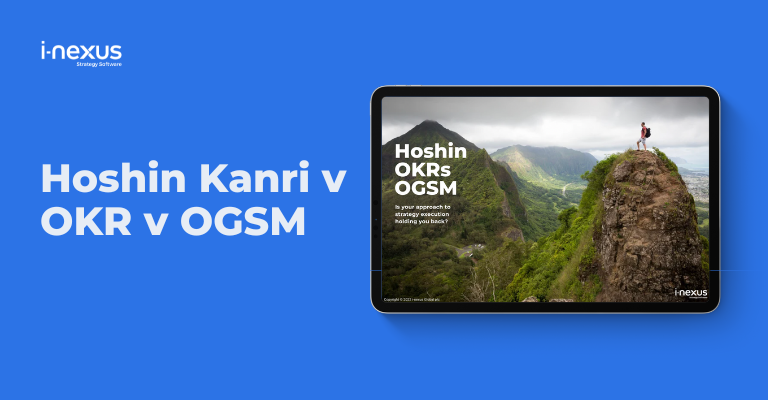As a senior leader in your organization, you should consider the role of KPIs, OKRs, breakthrough goals, and WIGs in keeping track of your performance. Let's explore the role they play in executing your strategy.
Written by: James Milsom, Head of Marketing
Businesses are built around goals.
The most effective way to reach your goals is to track your progress, align your strategic and operational projects in the same direction, and keep teams engaged throughout the process.
Businesses are becoming more complex and competitive. Measuring business performance and improving collaboration to ensure you achieve your goals and have the data needed to make mission-critical decisions has never been more vital.
As a senior leader in your organization, you should consider the role of KPIs, OKRs, breakthrough goals, and WIGs in keeping track of your performance. Today, we'll explore what each of these measurements means, and how they can help your strategy execution.
Key Performance Indicators
What is a Key Performance Indicator?
Key Performance Indicators (also known as KPIs) are quantitative performance benchmarks that gauge the success of a set goal or particular business activity.
KPIs can measure something as all-encompassing as financial performance, or they can be more process or individual-based, such as the number of calls made by a Sales Development Representative.
Types of KPIs include:
- Strategic
- Operational
- Functional
- Personal
- Leading
- Lagging
KPIs measure specific goals, while metrics focus on the organization's overall health. Crucially, all KPIs are metrics, but not all metrics are KPIs.
KPIs can be reported daily, weekly, or bi-weekly by posting on a KPI dashboard, for example. Their reporting should make up your on-going monthly, quarterly, and annual reviews, to show long-term trends.
However, it must be remembered that your KPIs, as too your goals, should be aligned with your strategic plan. Half of the challenge is tracking KPIs, but that says nothing about setting KPIs which keep your teams focused on strategic goals and how they contribute.
To that end, hoshin kanri methods such as the x-matrix are invaluable.
What does a KPI include?
When building your KPI, you should keep this checklist in mind:
- The outcome you seek
- Measurable aspects, such as phone calls
- The way you will measure the progress, such as calls placed
- How to affect change in performance, such as an action plan for supplying more leads to your Sales team
- Setting benchmarks or jump off points (hoshin kanri)
- Corrective measures which can be taken if performance dips
- Risks in achieving your outcome
- Frequency of reviewing the progress
Tips on writing your KPIs
As for formalizing the KPI, consider these tips:
- Trace your KPIs back to your strategic plan
- State the Key Performance Questions (KPQs)
- Evaluate your existing data
- Collect additional vital data
- Define the KPI measurement frequency
- Define SMART (specific, measurable, actionable, relevant, and time-bound) goals
- Share and delegate the KPIs, which acts as a natural way to assess if they meet the clear, concise, and relevant criteria (everyone should understand them)
- Avoid KPI overload - not everything needs to be a KPI
What makes a great KPI?
A great KPI is like any element of your strategic plan. Concise, clear, and relevant. That means:
- It provides clear, objective evidence of progress
- The measurement feeds better decision making
- Changes in performance are tracked and measured over time
- Covers efficiencies, governance, risk, financial, project performance, and much more
- Some are leading (predicting future performance, such as one part of a process being completed will lead to a direct impact on the next step) and others lagging (performance after the fact, such as the total number of calls made)
And, ultimately, the KPI must be acted upon, as a measurement for measurement's sake is not a good use of anyone's time.
Example KPIs
Here are three KPIs to demonstrate the above.
| Type | Outcome | Measure |
| Strategic | Reduce carbon emissions by 45% | CO2 emissions |
| Operational | Increase OEE by 10% | Quality, Performance, and Availability |
| Personal | Connect with 30 leads in a day | Number of dials made and connected |
Objectives and Key Results
What is an OKR?
Objectives and Key Results (OKRs) is a collective goal-setting approach that highlights your goals and what you need to do to accomplish them.
OKRs are great for developing strategic plans by tracking progress, creating adjustments, and boosting engagement around quantifiable goals.
OKRs differ from KPIs in that the latter is a measurement existing within a structure, while OKR is a strategic structure.
While reporting OKRs, break them down and report monthly or quarterly on a scorecard where all stakeholders have access.
What does an OKR include?
When building your OKRs, you should keep this in mind:
- Define your objective - Give a description of what you want to achieve, keeping it short and aspirational to engage, motivate and challenge your organization.
- Define key results - What are the crucial measurements needed to gauge delivery, normally two-five are attached to each objective, and can cover completion rates, monetary value, stock count etc.
- Share and track - Ensure the OKR is easily understood and actionable, with responsibilities and accountabilities set, with regular review sessions and learnings applied along the way.
Tips on writing your OKRs
As for writing your OKRs, consider these tips:
- Point out the areas that require growth
- Develop quantifiable OKRs
- Communicate with the entire team
- Develop progress mechanisms such as charts
- Track progress and adjust accordingly
The process for great OKRs
When it comes to the process, follow this method:
- Plan and align - Set at both a top-down and bottom-up perspective, the OKR planning stage looks at setting objectives and key results for a unit or team that links to the wider, long-term strategy.
- Status update - Moving into the status update, this can occur on a weekly or biweekly basis, with the purpose of gauging implementation flow and identifying delivery issues.
- Review - Reviews are an opportunity to look back at the definition, execution, and results achieved from the OKR, looking at the OKR in line with other OKRs to spot any higher-level delivery issues.
- Retrospect - With the review data gathered, the retrospective takes these learnings and looks at the process of the OKR itself. What worked, what didn't work, and what can we improve for the next OKR cycle.
Example OKRs
Here are three OKRs to demonstrate the above.
| Function | Objective | Key result |
| Sales | Obtain more prospects to boost signups by 40% beginning February through to May |
|
| Marketing | Launch four new quarterly newsletters in 2023 |
|
| PR |
Boost brand awareness by 15% annually |
|
Breakthrough goals
What is a breakthrough goal?
A breakthrough is a long-term (three to five years) goal you can achieve by making significant changes in your organization.
As part of the hoshin kanri methodology, breakthroughs are overarching and push you well beyond your existing performance levels. The mantra is that in order for you to achieve real, transformational change, you need to do things drastically different.
Breakthroughs have annual goals sitting within them, acting as short-term goals to help you deliver on your larger aims.
In most cases, to achieve a breakthrough goal, you must introduce new, challenging and aggressive strategic plans.
A breakthrough goal is different from a KPI. While a breakthrough goal is just that, a goal, a KPI is a measure you deploy to assess the success of the breakthrough. The KPI can also be known as a target to improve, in hoshin terminology.
While breakthrough goals are long-term, you can break them down and report monthly, quarterly, or annual results via a dashboard such as the bowling chart.
Tips on writing breakthrough goals
As for writing your breakthroughs, consider these tips:
- Keep your customer front and center with your formulation
- Ask if your breakthrough will help your customers in a way they wouldn't expect you at present
- What obstacles do you anticipate will prevent you from delivering on this three-five year horizon?
- Which resources do you need to succeed? Are they capable of being ring-fenced, or will operational work take precedent?
Example breakthrough goal
Here is one breakthrough, its annual objectives, and targets to improve to demonstrate the above.
| Breakthrough | Annual goals | Targets to improve |
| Improve Group revenue to $500m by 2023, whilst maintaining 15% margin | Create a customer-focused culture |
|
| Develop new product |
|
|
|
Add and retain high-value customers |
|
Wildly Important Goals
What is a WIG?
Wildly Important Goals (WIGs) are two or three significant goals that you must focus on and accomplish by a particular time.
Achieving WIGs is the first step in the 4DX framework – 4 Disciples of Execution. 4DX is a Strategy Execution operation system that teaches the importance of focus, leverage, engagement, discipline, and accountability, promoting lasting behavioral change.
According to the 4DX principles, you should only focus on a few goals to maximize energy input and boost success. These principles are:
- Focus on a small number of “Wildly Important Goals” (WIGs)
- Identify and act on the small number of impactful activities that will drive progress
- Track progress with a “compelling scoreboard”
- Promote accountability with regular supportive reviews.
What does a WIG include?
When building your WIGs, ensure they include:
- A quantifiable objective
- Deadlines to maintain focus and create urgency
Tips on writing your WIGs
As for writing your WIGs, consider these tips:
- Brainstorm with all stakeholders to identify the most vital goals.
- Breakdown the chosen goals and discuss lead measures for improved clarity
- Delegate goal's responsibility
- Track progress via regular meetings
- Keep and maintain a scorecard
The process for great WIGs
As for the process, follow this WIG method:
- Define - Create your Wildly Important Goals based on a thorough analysis of your environments, settling on 1-2 WIGs that warrant delivery.
- Deploy - Deploy the WIGs and form individual goals and action plans which will ensure that your team is clear on how they must support you.
- Execute - Hold a launch event to mark the WIGs being live, alongside a process to drive execution and monitoring via a
scorecard. - Review - Regularly review the delivery of the WIGs, reinforcing the process of execution action plans, projects, and supporting actions. Surface issues here.
- Optimize - Create a space for collaboration and ideas to improve performance, and measure their impact, all the while celebrating success, and addressing missed leading metrics.
Example WIGs
Here are three example WIGs to demonstrate the above.
| Type | Objective |
| Marketing | Expand into the as-a-service category with a market-defining service offering, establishing a 50% market share by 2026 |
| Corporate | Eliminate all carbon emissions by shifting global manufacturing plants to renewable energy powered operations |
| Product |
Introduce a new product offering to our key growth accounts, converting lower revenue customers into brand champions |
How do OKRs, breakthrough goals, and WIGs relate?
In most organizations, goal setting follows a top-down framework. This means that goals are often set at a corporate level, only to be passed down to the frontline, which leads to the disconnect between plans and reality - and is the main cause of the strategy execution gap.
But OKRs don't cascade. Executive management identifies the strategic goals, and the individual teams develop their tactical OKRs. There is a marrying of the two which needs to take place. That is where the goal techniques like catchall come in.
OKRs and WIGs contribute to the overall success of the business, and using these as part of your performance management system is sensible. However, they should be combined with longer-term, breakthrough goals for connective tissue between front-line and strategic ambitions.
Performance measurement matters
Only 15% of employees know their organization's goals, and 90% of businesses fail to execute their strategic plans successfully.
With such numbers, you can't overlook the importance of KPIs, OKRs, breakthrough goals, and WIGs.
These tools enable you to collect and utilize vital data to understand your execution.
However, they all need to work harmoniously to avoid discontinued data that'd otherwise return invalid insights, hence poor decision-making.
That's where i-nexus comes in.
i-nexus strategy execution software tracks everything that matters, enabling invaluable insights for strategic and operational excellence.
With portfolios of always-on activity in your organization, keeping track of performance is resource-intensive, but i-nexus transforms your performance management.
By using i-nexus to manage the performance of your strategic and operational work, you’ll be equipped with KPIs, metrics, and reports which ensure you always know if everything is going to plan.
Let us show you how, by watching our on-demand demo.
Learn more about improving your strategy execution
Continue exploring how to improve your strategy delivery by visiting our hoshin kanri knowledge hub, or with any of the below:
- 4 ways to align corporate and functional plans: Realizing your goals means coordinating a great deal across your organization. Here are four ways to link corporate and functional strategic plans.
- Download our key to strategy execution eBook: Read how companies like Danaher and HP have mastered Strategy Execution Management and what you can learn from them.
- What does it mean to be an agile business?: Take the leap into the future of strategic planning and execution with this fascinating insight.
About the author
Here at i-nexus, I want to help you develop and find easier, more effective ways to deliver more of your goals, with less effort. As part of that, I'm passionate about creating the best content to overcome your challenges. Ask me about Hoshin Kanri and operational excellence guides for free copies.
If you’d like to talk more about Strategy Execution, reach out to me at james.milsom@i-nexus.com or connect with me on LinkedIn for the latest insights.





